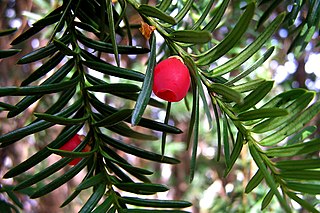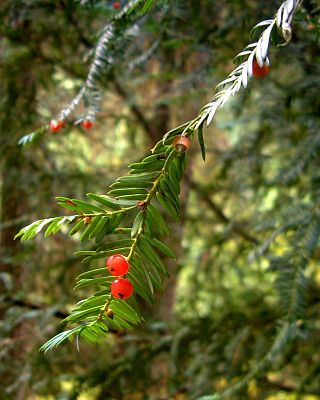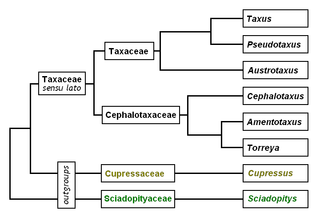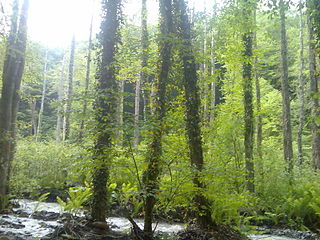
Taxus is a genus of coniferous trees or shrubs known as yews in the family Taxaceae. They are relatively slow-growing and can be very long-lived, and reach heights of 2.5–20 m (8.2–65.6 ft), with trunk girth averaging 5 m (16 ft). They have reddish bark, lanceolate, flat, dark-green leaves 10–40 mm long and 2–3 mm broad, arranged spirally on the stem, but with the leaf bases twisted to align the leaves in two flat rows either side of the stem. The oldest known fossil species are from the Early Cretaceous.

Taxaceae, commonly called the yew family, is a coniferous family which includes six extant and two extinct genera, and about 30 species of plants, or in older interpretations three genera and 7 to 12 species.

An aril, also called an arillus, is a specialized outgrowth from a seed that partly or completely covers the seed. An arillode or false aril is sometimes distinguished: whereas an aril grows from the attachment point of the seed to the ovary, an arillode forms from a different point on the seed coat. The term "aril" is sometimes applied to any fleshy appendage of the seed in flowering plants, such as the mace of the nutmeg seed. Arils and arillodes are often edible enticements that encourage animals to transport the seed, thereby assisting in seed dispersal. Pseudarils are aril-like structures commonly found on the pyrenes of Burseraceae species that develop from the mesocarp of the ovary. The fleshy, edible pericarp splits neatly in two halves, then falling away or being eaten to reveal a brightly coloured pseudaril around the black seed.

The American badger is a North American badger similar in appearance to the European badger, although not closely related. It is found in the western, central, and northeastern United States, northern Mexico, and south-central Canada to certain areas of southwestern British Columbia.

Taxus baccata is a species of evergreen tree in the family Taxaceae, native to western, central and southern Europe, northwest Africa, northern Iran, and southwest Asia. It is the tree originally known as yew, though with other related trees becoming known, it may now be known as common yew, English yew, or European yew. It is primarily grown as an ornamental. Most parts of the plant are poisonous, with toxins that can be absorbed through inhalation and through the skin; consumption of even a small amount of the foliage can result in death.
NVC community W13, also known as Yew woodland, is one of the woodland communities in the British National Vegetation Classification system; it is the only Yew woodland community in the NVC.

Taxus cuspidata, the Japanese yew or spreading yew, is a member of the genus Taxus, native to Japan, Korea, northeast China and the extreme southeast of Russia.

Taxus brevifolia, the Pacific yew or western yew, is a species of tree in the yew family Taxaceae native to the Pacific Northwest of North America. It is a small evergreen conifer, thriving in moisture and otherwise tending to take the form of a shrub.

Taxanes are a class of diterpenes. They were originally identified from plants of the genus Taxus (yews), and feature a taxadiene core. Paclitaxel (Taxol) and docetaxel (Taxotere) are widely used as chemotherapy agents. Cabazitaxel was FDA approved to treat hormone-refractory prostate cancer.

Taxus canadensis, the Canada yew or Canadian yew, is a conifer native to central and eastern North America, thriving in swampy woods, ravines, riverbanks and on lake shores. Locally called simply "yew", this species is also referred to as American yew or ground-hemlock.

Taxus chinensis is a species of yew. It is commonly called the Chinese yew, though this term also refers to Taxus celebica or Taxus sumatrana.

Taxus floridana, the Florida yew, is a species of yew, endemic to a small area of under 10 km² on the eastern side of the Apalachicola River in mesophytic forests of northern Florida at altitudes of 15–40 m. It is listed as critically endangered. It is protected in reserves at the Torreya State Park and at the Nature Conservancy's Apalachicola Bluffs and Ravines Preserve, and has legal protection under the United States and Florida Endangered Species laws.

Taxus globosa, the Mexican yew, is an evergreen shrub and one of the eight species of yew. The Mexican yew is a rare species, only known to be found in a small number of locations in eastern Mexico, Guatemala, El Salvador and Honduras, and is listed as an endangered species. The Mexican yew is a shrub that grows to an average height of 4.6m. It has large, sharp light green needles growing in ranks on either side of its branches.

The Western Himalayan subalpine conifer forests is a temperate coniferous forests ecoregion of the middle and upper elevations of the western Middle Himalayas of Nepal, India, and Pakistan.

Yew is a common name given to various species of trees.

Yunnanxane is a bioactive taxane diterpenoid first isolated from Taxus wallichiana. Yunnanxane was later isolated from cell cultures of Taxus cuspidata and Taxus chinensis. Four homologous esters of yunnanxane have also been isolated from Taxus. Yunnanxane is reported to have anticancer activity in vitro.

Taxinine M is a tetracyclic taxane isolate derived from Taxus brevifolia, Taxus chinensis, and Taxus mairei.

Taxine alkaloids, which are often named under the collective title of taxines, are the toxic chemicals that can be isolated from the yew tree. The amount of taxine alkaloids depends on the species of yew, with Taxus baccata and Taxus cuspidata containing the most. The major taxine alkaloids are taxine A and taxine B although there are at least 10 different alkaloids. Until 1956, it was believed that all the taxine alkaloids were one single compound named taxine.

Taxus × media, sometimes known simply as Taxus media, is a conifer created by the hybridization of English yew Taxus baccata and Japanese yew Taxus cuspidata. This hybridization is thought to have been performed by the Massachusetts-based horticulturalist T.D. Hatfield in the early 1900s.

Batsara Strict Nature Reserve is a protected area in Akhmeta Municipality, Kakheti region of Georgia in Pankisi Gorge on the bank of Alazani River, 700–2,000 meters above sea level at the foot of the Greater Caucasus. It borders with Ilto Managed Reserve which includes part of Ilto valley.


















